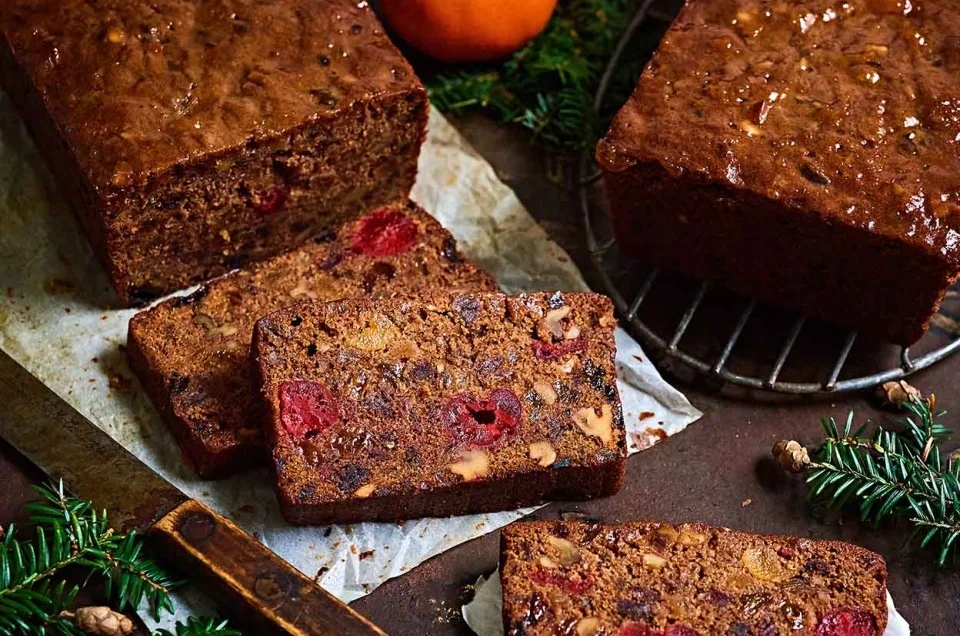Christmas Fruitcake! – A Catalog Time-Capsule
Vintage Ads from 1950–1989: Sears, JCPenney & Montgomery Ward
The Christmas fruitcake. Few desserts divide opinion as sharply. To some, it’s a cherished tradition—a dense, jewel-toned brick studded with candied cherries, pineapple, and pecans, lovingly wrapped in festive foil and passed down through generations. To others, it’s a culinary mystery, a mystery wrapped in a cake, wrapped in plastic, and regifted every December with a polite smile. But regardless of your stance, the fruitcake has played a starring role in American holiday culture for over a century. And nowhere is its legacy more vividly preserved than in the pages of vintage department store catalogs.
From the postwar optimism of the 1950s to the neon-lit consumerism of the 1980s, fruitcake wasn’t just food—it was a symbol. A symbol of abundance, of nostalgia, of the idealized American Christmas. And in the glossy pages of Sears, JCPenney, and Montgomery Ward, it was marketed with all the fanfare of a Hollywood starlet. This article dives deep into the golden age of fruitcake advertising, presenting curated scans from mid-century catalogs, comparing packaging evolution, and uncovering the stories behind the “holiday brick” that somehow persists.
We’ll explore who might have invented the modern fruitcake, analyze how its presentation changed across decades, and even offer a downloadable 8-page PDF mini-catalog recreating the vintage aesthetic. And yes—we’ll finally settle the debate: do you love it, regift it, or use it as a doorstop? Let’s unwrap the history, one candied peel at a time.
Who Really Invented the Holiday Brick?
The story of the fruitcake begins not in a 1950s American kitchen, but in the ancient world. The earliest known version of what we might call a fruitcake dates back to Roman times, where a dish called satura combined barley, pomegranate seeds, nuts, and honey into a dense, long-lasting loaf. This wasn’t dessert as we know it, but rather a portable energy food for soldiers and travelers—practical, calorie-dense, and shelf-stable.
Fast forward to medieval Europe, where dried fruits, spices, and honey became luxury items. By the 13th century, European bakers began crafting “plum breads” or “plum cakes”—though “plums” then referred to any dried fruit, including raisins and currants. These cakes were rich, dark, and often soaked in wine or brandy to preserve them. They were associated with special occasions, particularly Christmas, when families could afford the expensive imported ingredients.
The fruitcake as we recognize it today—dense, candied, and brightly colored—began to take shape in 18th and 19th century England. The Industrial Revolution made sugar and candied fruits more accessible, and British bakers perfected the recipe. It was during the Victorian era that the fruitcake became a centerpiece of the Christmas table, often aged for months and served with brandy butter.
But who brought it to America? That honor likely goes to British and German immigrants in the 1800s. They carried their holiday traditions across the Atlantic, and by the early 20th century, fruitcake had become a staple of American Christmas celebrations. However, it wasn’t until the 1930s and 1940s that the fruitcake became a mass-market product, thanks to companies like Collin Street Bakery in Texas and Claxton Bakery in Georgia.
Collin Street Bakery, founded in 1896, began shipping fruitcakes by mail order in the 1910s. During World War II, they sent thousands of cakes to American soldiers overseas, cementing the fruitcake’s reputation as a durable, morale-boosting gift. After the war, the demand exploded. Department stores saw an opportunity.
By the 1950s, fruitcake wasn’t just homemade—it was cataloged. Sears, JCPenney, and Montgomery Ward all featured fruitcakes in their Christmas Wish Books, offering them as ready-made gifts for the busy modern family. These weren’t artisanal creations; they were mass-produced, shrink-wrapped, and sold alongside electric trains and nylon stockings. The fruitcake had officially entered the consumer mainstream.
So, did one person “invent” the fruitcake? Not really. It was a culinary evolution, shaped by trade, migration, and technology. But if we’re assigning credit for turning it into a holiday institution, we might thank the Victorian bakers for the recipe, the immigrant communities for bringing it to America, and the mid-century retailers for turning it into a catalog star.
Curated Scans: Fruitcake Ads from 1950–1989
To truly appreciate the cultural journey of the fruitcake, we need to go straight to the source: the catalogs themselves. Below are carefully selected scans from Sears, JCPenney, and Montgomery Ward holiday editions spanning four decades. Each ad reflects not just the product, but the aesthetics, values, and marketing strategies of its time.
1950s: The Golden Age of Abundance
The 1950s were a time of postwar prosperity. Suburbs were booming, families were growing, and consumerism was king. Fruitcake ads from this era emphasize quality, tradition, and generosity. The cakes are often shown in elegant wooden boxes or wrapped in gold foil, suggesting luxury and care.
Sears, 1955: “Rich, moist fruitcake—perfect for gift-giving!”
The language is warm and inviting: “Hand-packed with plump raisins, cherries, and citron,” one ad promises. Another boasts, “A tradition your family will treasure.” Notice the absence of nutrition facts or ingredient lists—this was an era when “rich” and “moist” were selling points, not warnings.
1960s: Color, Kitsch, and Convenience
The 1960s brought bolder colors and a shift toward convenience. Fruitcake ads begin to feature plastic packaging, transparent windows, and cheerful holiday graphics. The focus is on ease: “Ready to serve!” and “No refrigeration needed!”
JCPenney, 1967: “The festive fruitcake everyone loves!”
Some ads even suggest serving the cake with whipped cream or ice cream, trying to make it more appealing to younger generations. The tone is upbeat, almost playful, reflecting the decade’s cultural shifts.
1970s: The Rise of the Bargain
By the 1970s, inflation and economic uncertainty made value a top concern. Fruitcake ads now highlight low prices and bulk savings. “Buy two, get one free!” and “Only $4.99!” are common slogans.
Montgomery Ward, 1974: “Delicious fruitcake at a price you’ll love.”
The packaging looks more utilitarian—cardboard boxes with simple labels. The emphasis is on practicality, not prestige. Still, the cake is described as “handmade” and “old-fashioned,” appealing to nostalgia even as budgets tightened.
1980s: The Peak of Consumer Excess
The 1980s were all about excess. Fruitcake ads return to luxury, with gift sets, branded packaging, and even miniature fruitcakes for party favors. Some catalogs offer fruitcake paired with liqueur, cheese, or cookies.
Sears, 1985: “The ultimate holiday gift basket.”
The language is bold: “Decadent,” “Gourmet,” “Imported fruits.” This was the height of fruitcake as a status symbol—something to display, not just eat. But beneath the glitter, the seeds of satire were growing. Late-80s humor began to mock the fruitcake as an unwanted gift, setting the stage for its modern reputation.
Side-by-Side: 1955 vs. 1985 Packaging
Let’s take a closer look at how fruitcake packaging evolved over 30 years. Below is a direct comparison of a 1955 Sears fruitcake ad and a 1985 Sears fruitcake gift set.
- Material: Gold foil wrap with paper band
- Design: Elegant script, holly motifs
- Message: “A gift of distinction”
- Price: $2.29
- Focus: Tradition, quality, simplicity
- Material: Plastic clamshell with cardboard sleeve
- Design: Bright colors, bold fonts, “GOURMET” in all caps
- Message: “Luxury holiday indulgence”
- Price: $14.99 (with brandy)
- Focus: Excess, branding, giftability
The contrast is striking. In 1955, the fruitcake is presented as a simple, elegant gift—something handmade and heartfelt. By 1985, it’s a commercial product, part of a larger lifestyle package. The price has increased more than sixfold (even adjusting for inflation), reflecting its transformation from food to experience.
Yet both ads share one thing: the promise of joy. Whether wrapped in foil or plastic, the fruitcake remains a symbol of holiday generosity—even if, today, that generosity sometimes means passing it on to someone else.
Downloadable 8-Page PDF Mini-Catalog
Inspired by the vintage ads we’ve explored, we’ve created a nostalgic 8-page PDF mini-catalog that recreates the look and feel of a 1960s department store holiday supplement. Inside, you’ll find:
- Reimagined fruitcake ads from 1955–1985
- Mock holiday gift guides featuring fruitcake
- Vintage-style illustrations and typography
- Factual tidbits about fruitcake history
- A printable fruitcake gift tag template
This PDF is perfect for collectors, educators, or anyone who loves mid-century design. It’s free to download and use for personal or classroom purposes.
Poll: Love It, Regift It, or Doorstop?
The fruitcake has become a cultural punchline. Comedians joke about its durability. Internet memes claim it’s been passed around since 1913. But what do you really think?
What’s your relationship with fruitcake?
Your vote helps us understand how perceptions of this iconic dessert have changed. Results will be shared in a future update!
Why the Fruitcake Endures
Despite the jokes, the fruitcake isn’t going anywhere. In fact, recent years have seen a retro revival. Artisanal bakeries are reimagining the fruitcake with organic fruits, bourbon-soaked cherries, and sustainable packaging. Food historians are reclaiming its legacy. And nostalgic consumers are rediscovering its charm.
The fruitcake’s longevity isn’t just about taste—it’s about tradition, memory, and ritual. For many, it’s the smell of Grandma’s kitchen, the excitement of opening a holiday box, or the humor of receiving the same cake every year. It’s not just a dessert; it’s a time capsule.
And in the pages of vintage catalogs, that time capsule is perfectly preserved. Each ad tells a story—not just of a cake, but of a nation celebrating, shopping, and dreaming of the perfect Christmas.









